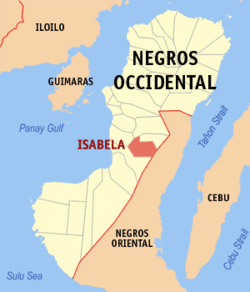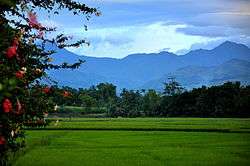Isabela, Negros Occidental
| Isabela | |
|---|---|
| Municipality | |
| Municipality of Isabela | |
|
Brgy. Camangcamang with Mabinay Mountains in the distance | |
 Map of Negros Occidental with Isabela highlighted | |
.svg.png) Isabela Location within the Philippines | |
| Coordinates: 10°12′N 122°59′E / 10.200°N 122.983°ECoordinates: 10°12′N 122°59′E / 10.200°N 122.983°E | |
| Country | Philippines |
| Region | Negros Island Region (NIR) |
| Province | Negros Occidental |
| Congr. district | 5th district of Negros Occidental |
| Barangays | 30 |
| Government[1] | |
| • Mayor | Enrique "Quito" G. Montilla, III |
| Area[2] | |
| • Total | 178.76 km2 (69.02 sq mi) |
| Population (2010)[3] | |
| • Total | 59,523 |
| • Density | 330/km2 (860/sq mi) |
| Time zone | PST (UTC+8) |
| ZIP code | 6128 |
| Dialing code | 34 |
Isabela is a second class municipality in the province of Negros Occidental, Philippines. According to the 2010 census, it has a population of 59,523 people.[3] Isabela is known for BISCOM (Binalbagan Isabela Sugar Company).
In 1951, the barrios of Magallon, Odiong and Guinpanaan were separated from Isabela and formed into the town of Magallon (now Moises Padilla).[4]
Barangays
Isabela is politically subdivided into 30 barangays ("Pob." means poblacion).[2]
- Amin
- Banogbanog
- Bulad
- Bungahin
- Cabcab
- Camangcamang
- Camp Clark
- Cansalongon
- Guintubhan
- Libas
- Limalima
- Makilignit
- Mansablay
- Maytubig
- Panaquiao
- Barangay 1 (Pob.)
- Barangay 2 (Pob.)
- Barangay 3 (Pob.)
- Barangay 4 (Pob.)
- Barangay 5 (Pob.)
- Barangay 6 (Pob.)
- Barangay 7 (Pob.)
- Barangay 8 (Pob.)
- Barangay 9 (Pob.)
- Riverside
- Rumirang
- San Agustin
- Sebucawan
- Sikatuna
- Tinongan
Demographics
| Population census of Isabela | ||
|---|---|---|
| Year | Pop. | ±% p.a. |
| 1990 | 47,010 | — |
| 1995 | 49,019 | +0.79% |
| 2000 | 48,719 | −0.13% |
| 2007 | 58,819 | +2.63% |
| 2010 | 59,523 | +0.43% |
| Source: National Statistics Office[3][5] | ||
Festival
"Tigkalalag" is celebrated on the evening of Nov. 2 every year in the town of Isabela.[6] The Pana-ad victory of Tigkalalag festival is expected to boost the attraction of this unique festival that began in Purok Manacup beside the public cemetery in Isabela town where people would have fun during the night of All Souls Day that was capped with a beauty pageant called Search for the White Lady. It spun off into the municipal festival under Mayor Renato Malabor, when the town was searching for a festival that was going to be its tourism plank.
Tigkalalag festival of Isabela turned what otherwise are morbid concepts of coffins, candelabras and crashing tombs into a whimsical, tightly-designed, skillfully-choreographed presentation that sent it howling to success in yearly competition of all the festivals of Negros Occidental. Tigkalalag is Hiligaynon for All Souls' Day.
References
- ↑ "Municipalities". Quezon City, Philippines: Department of the Interior and Local Government. Retrieved 6 March 2013.
- 1 2 "Province: Negros Occidental". PSGC Interactive. Makati City, Philippines: National Statistical Coordination Board. Retrieved 6 March 2013.
- 1 2 3 "Total Population by Province, City, Municipality and Barangay: as of May 1, 2010" (PDF). 2010 Census of Population and Housing. National Statistics Office. Retrieved 5 March 2013.
- ↑ "An act creating the municipality of Magallon in the province of Negros Occidental". LawPH.com. Retrieved 2011-04-09.
- ↑ "Province of Negros Occidental". Municipality Population Data. LWUA Research Division. Retrieved 19 August 2013.
- ↑ "Municipality of Isabela". Negros Occidental Provincial Government. Retrieved 6 March 2013.
External links
- Philippine Standard Geographic Code
- Isabela Profile at the Official Website of Negros Occidental
- Philippine Census Information
- Municipality of Isabela
- Local Governance Performance Management System
 |
La Castellana / Moises Padilla |  | ||
| Hinigaran | |
Guihulngan, Negros Oriental | ||
| ||||
| | ||||
| Binalbagan |
